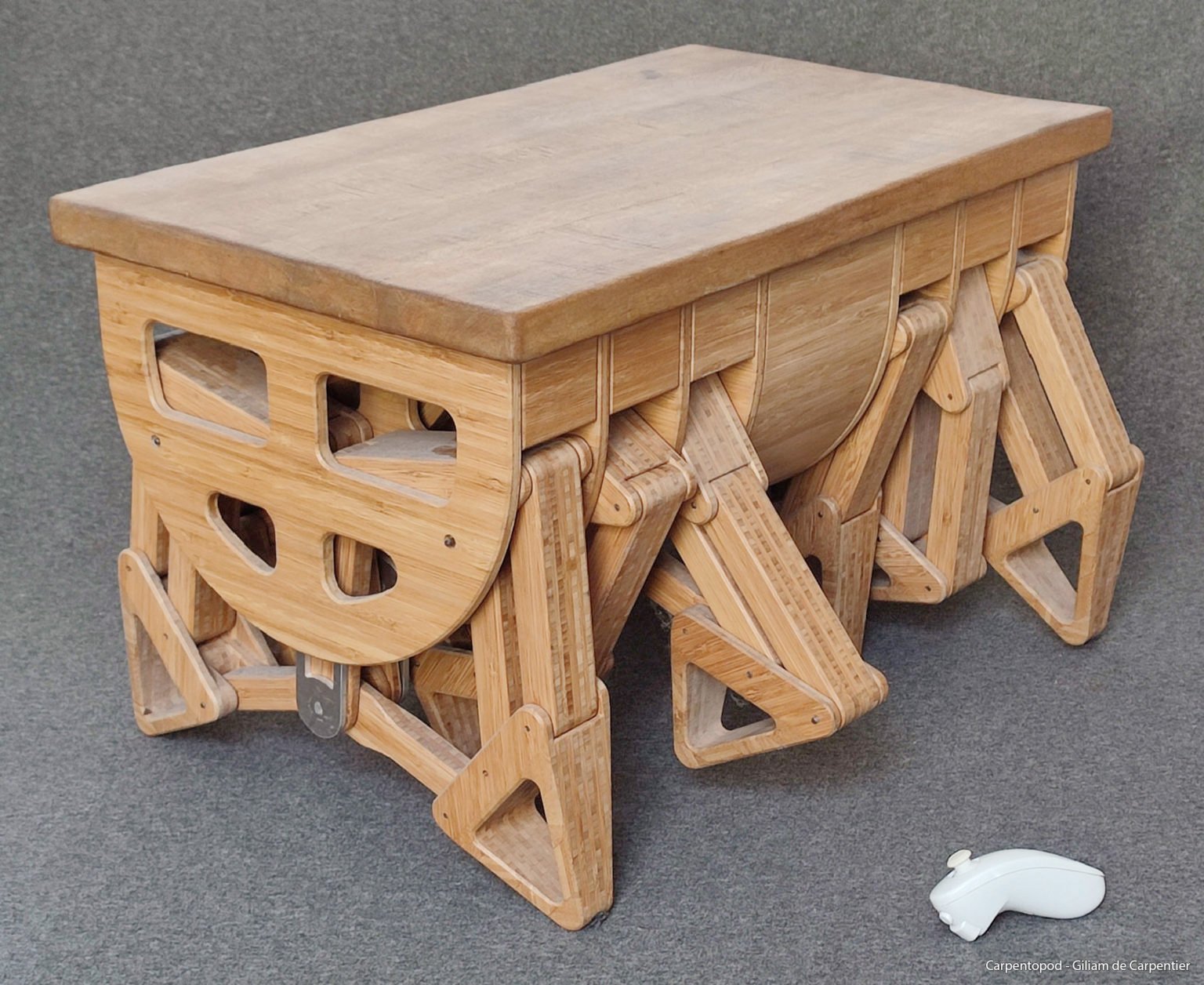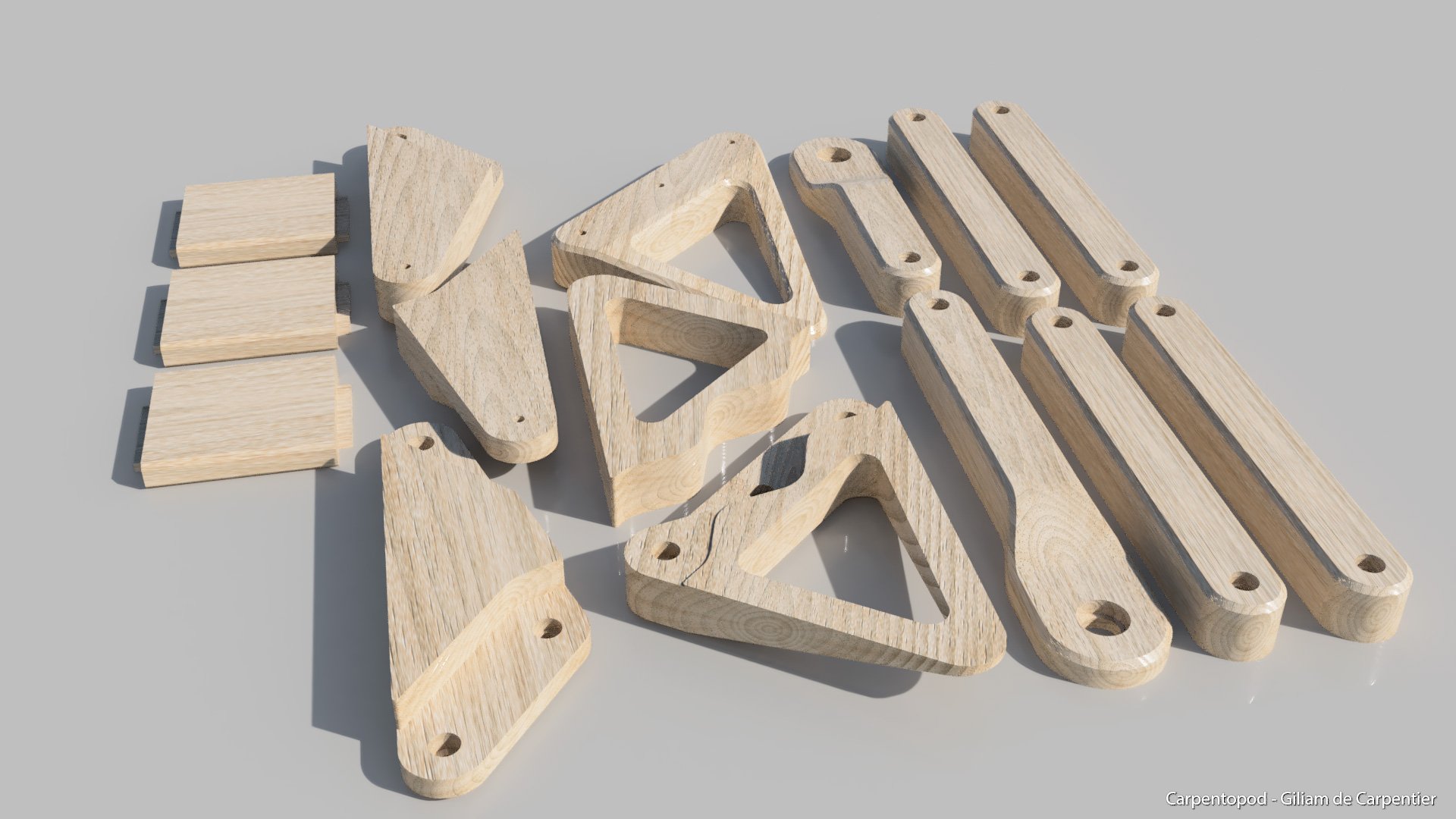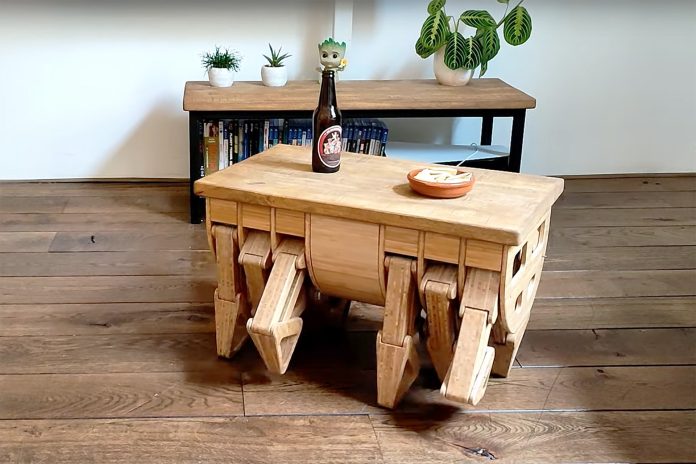The Carpentopod, a 12-legged walking wooden table created by Dutch craftsman Giliam de Carpentier, adds a new dimension to furniture design. Combining the ingenuity of robotics with handcrafted woodwork, Carpentopod is designed to serve drinks and snacks autonomously through remote control. While the structure may evoke Theo Jansen’s famous Strandbeest sculptures, de Carpentier explains that Carpentopod’s design is distinct. “Although there are similarities in appearance, the component ratios and extra joint points are different,” he says. These structural modifications allow Carpentopod a unique gait, enhanced by rounded toe diameters that contribute to its distinct movement.
Craftsmanship meets technology
Carpentopod’s mechanics are straightforward but carefully engineered. The table comprises two main sections, each powered by a 24V brushless motor with 1.5 Nm of torque and a rotation speed of 130 RPM. Each motor powers six legs, creating a synchronized motion that enables the table to “walk” smoothly. These brushless motors, typically used for automated curtains, are affordable yet capable of generating the precise movements required for this unique furniture piece.
A single crankshaft drives each section, enabling the user to give the table a gentle push forward, at which point it will continue moving autonomously. With a Bluetooth module connected to an Arduino single-board computer, Carpentopod can be operated remotely using a wireless Nunchuck controller—repurposed from a Nintendo Wii system. Additionally, a LiPo battery powers the table, allowing for untethered movement. This setup enables Carpentopod to navigate a space, bring drinks or snacks to its user, and even park itself when no longer in use.
The crafting process
To build Carpentopod, de Carpentier relied on a three-axis CNC router, allowing him to create twelve identical wooden leg pieces with high precision. He used laminated bamboo, a durable and flexible material, for the legs. Since the CNC router’s limitations meant he couldn’t create intricate shapes from a single block, de Carpentier designed each leg as a set of three sheets. Each sheet was cut individually and then glued together to form the final leg piece. This layered approach allowed for greater structural integrity and flexibility in achieving the desired form.

Once the legs were completed, de Carpentier moved on to the two crankshafts, which he made by machining aluminum rods and sheets using CNC. The rods were carefully assembled by hammering D-shaped shafts together, resulting in a sturdy, interconnected structure that animates Carpentopod’s walking motion.
Unique design features
In addition to its mechanical features, Carpentopod’s aesthetic design is both functional and visually appealing. The table has a central hollow area, referred to as the “belly,” which serves as a storage compartment for its electronics, motors, and battery. The craftsman designed this section with a curved, upside-down chest-like appearance, giving it a warm, organic look.
To create the curved doors of the belly, de Carpentier used a technique called kerfing, which involves making fine cuts in the bamboo to increase its flexibility. The bamboo was then steamed and dried in a curved jig to retain its shape, allowing the doors to fit snugly while remaining easy to open and close. The doors are attached with invisible hinges and embedded magnets, adding a smooth, seamless quality to the design. The choice of mango timber for the table’s top complements the surrounding furniture in de Carpentier’s living room, tying Carpentopod into the overall aesthetic of his home.

Practical utility and appeal
Though Carpentopod may seem like a novelty at first glance, its potential practical uses make it an intriguing addition to any household. By serving drinks and snacks at the user’s command, it brings a touch of convenience and whimsy to home living. The table’s unique ability to walk autonomously means it can be positioned flexibly, responding to changes in the user’s needs and providing service in a truly novel way. The table’s remote-controlled walking feature adds to its appeal, making it not just a conversation piece but a functional piece of furniture.
Final thoughts
While Carpentopod is certainly a fascinating fusion of art and technology, it also exemplifies the potential for robotics to intersect with everyday life in unexpected ways. This handcrafted walking table stands out as an impressive piece of functional art, combining advanced mechanical design with traditional woodworking techniques. With its blend of aesthetic appeal and practical functionality, Carpentopod reflects de Carpentier’s vision of creating furniture that can do more than just stand in one place. Whether as a centerpiece in a living room or as an interactive piece in a creative workspace, Carpentopod brings movement, personality, and utility to the modern home.
Source: Giliam de Carpentier



